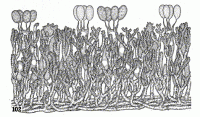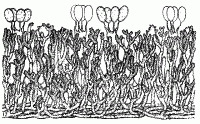|
 Aleurodiscus coronatus Aleurodiscus coronatus
SynonymsAcanthophysium coronatum
BiostatusPresent in region - Indigenous. Endemic
Images (click to enlarge)
Caption: Fig. 102. Acanthophysium coronatum. Showing the coralloid acanthophyses, large
gloeocystidia with irregular apical processes, and delicately aculeate elliptical spores. | 
Caption: FIG. 12. Aleurodiscus coronatus. Transverse section, showing coralloid, coronate
gloeocystidia and submerged paraphyses, x 500. |
Article: Cunningham, G.H. (1963). The Thelephoraceae of Australia and New Zealand. New Zealand Department of Scientific and Industrial Research, Bulletin 145: 359 p. Wellington:.
Description: Hymenophore annual, coriaceous, adherent, effused forming linear areas to 10 x 1 cm;
hymenial surface white, then pallid cream, finally creviced; margin thinning out,
white, fibrillose, adherent. Context white, 100-150 µ thick, basal layer of a few
intertwined hyphae, intermediate layer scanty, of erect hyphae, embedding masses of
crystals; generative hyphae to 4 µ diameter, walls 0.25 µ thick, naked, with clamp
connections. Acanthophyses coralloid, arising from the base of the intermediate layer
and forming the bulk of the hymenial layer, apically branched and covered with fine
spines, some of the pedicels spinose, others naked. Gloeocystidia arising in the basal
layer, some penetrating the hymenium, narrowly ovate, clavate, or broadly fusiform,
50-80 x 20-28 µ, apically crowned with irregular spinous processes. Hymenial layer to
60 µ deep, a scattered palisade of basidia, paraphyses, acanthophyses, and
gloeocystidia. Basidia cylindrical, 50-65 x 12-14 µ, bearing 4 spores; sterigmata
arcuate, subulate, to 16 µ long. Paraphyses cylindrical, fusiform, subclavate, or
obclavate, irregular, 30-60 x 8-12 µ. Spores elliptical or obovate, strongly apiculate,
16-22 x 8-12 µ, walls delicately verruculose, hyaline, 0.5 µ thick, amyloid.
Habitat: HABITAT: Effused on bark of dead branches and twigs.
Distribution: TYPE LOCALITY: Hunua Ranges, Auckland, New Zealand. DISTRIBUTION: New
Zealand.
Notes: Spines on spore walls may be seen only with an oil immersion objective, unless
spores are treated with Melzer's reagent, when they become more conspicuous.
Masses of crystals, often discoloured, are embedded in tissues of the context.
Gloeocystidia are large, conspicuous, and bear irregular spines at or near apices.
Acanthophyses are of the coralloid type but more delicate and thin-walled than
those of A. coralloides. In macrofeatures the species resembles A. aurantium, and in
New Zealand both develop upon the same host plant. Separation may be made by
the different gloeocystidia and spores.
Article: Cunningham, G.H. (1956). Thelephoraceae of New Zealand. Part XI. The genus Aleurodiscus. Transactions of the Royal Society of New Zealand 84(2): 237-268.
Description: Hymenophore annual, resupinate, coriaceous, adnate, effused forming linear areas to 10 x 1
cm; hymenial surface white, then pallid cream, finally creviced; margin thinning out, white,
fibrillose, adnate. Context white, 100-150 µ thick, basal layer of a few woven hyphae,
intermediate layer scanty, of upright hyphae, embedding masses of crystals; generative
hyphae to 4 µ diameter, walls 0.25 µ thick, hyaline, branched, septate, with clamp
connexions. Hymenial layer to 60 µ deep, a scattered palisade of basidia, paraphyses,
acanthophyses and gloeocystidia. Basidia cylindrical, 50-65 x 12-14 µ, 4-spored; sterigmata
arcuate, subulate, to 16 µ long. Paraphyses cylindrical, fusiform, subclavate or obclavate,
irregular, 30-60 x 8-12 µ. Acanthophyses coralloid, arising from the base of the intermediate
layer and forming the bulk of the hymenial layer, apically branched and covered with fine
spines, some of the pedicels spinose, others naked. Gloeocystidia arising in the basal layer,
some penetrating to the surface, narrowly ovate, clavate, or broadly fusiform, 50-80 x 20-28
µ, apically crowned with irregular spinous processes. Spores elliptical or obovate, strongly
apiculate, 16-22 x 8-12 µ, walls delicately verruculose, 0.5 µ thick, hyaline, amyloid.
Habitat: HABITAT. Effused on bark of dead branches and twigs.
Distribution: DISTRIBUTION. New Zealand.
Notes: Specific features are the resupinate effused thin hymenophore, acanthophyses of the coralloid
type, large coronate gloeocystidia and narrow, delicately verruculose, elliptic-obovate,
strongly apiculate, amyloid spores. Spines on spore walls may be seen as a rule only under an
oil immersion objective, unless spores are treated with Melzer's reagent when they become
more conspicuous. Masses of crystals, often discoloured, are embedded in the tissues of the
context. Gloeocystidia bear irregular spines at their apices, hence the specific name.
Acanthophyses are of the coralloid type but more delicate and thin-walled than those of A.
coralloides. In macrofeatures the species resembles A. aurantius, and both develop upon the
same host. Separation may be made by the different gloeocystidia and spores.
|